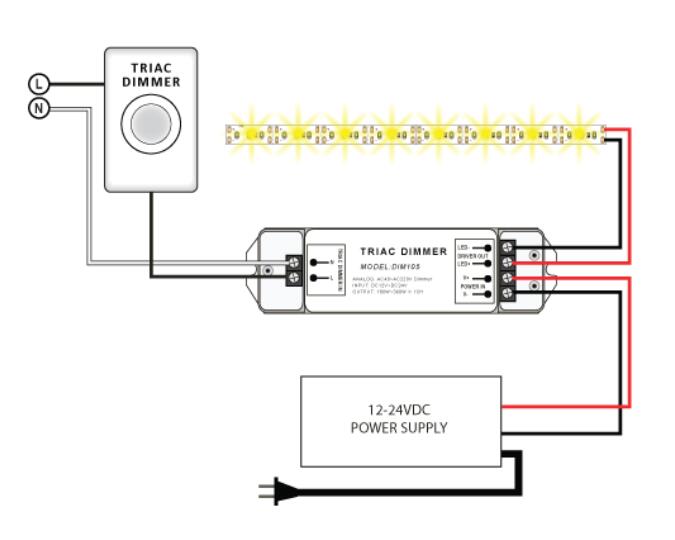
Dimming has totally changed how we manage lighting in our environment, and now with LED ultra-modern construction on the rise, the need for adaptable and highly effective dimmers is ever soaring.
This comprehensive exposition digs deeply into the intricacies of TRIAC dimming and its integration with LED lighting systems.
This guide opens a gateway to illuminating opportunities for readers, bridging the gap between fundamental principles and practical considerations.
By elucidating the decision-making process regarding the implementation of TRIAC dimming for LED lighting and presenting a plethora of customizable ambient options,we aim to furnish you with the requisite knowledge to transform your environment with energy-efficient luminosity.
What is a TRIAC Dimmer and How Does it Benefit LED Lights?

A TRIAC dimmer, an adaptable and widely employed control mechanism, bestows meticulous power modulation for illuminative applications. Denoted by its complete nomenclature “Triode for Alternating Current,” a TRIAC assumes the role of a switch, enabling efficacious control over power.
TRIAC dimmers, commonly referred to as phase-cut dimmers, have garnered immense popularity owing to their compatibility with LED lights – they are tailor-made for lighting systems.
Traditionally, configuring LED lights with phase-cut or TRIAC dimmers posed challenges. Quite luckily, technological advancements have spurred the emergence of specialized TRIAC dimming drivers tailored specifically for LED lights, considerably streamlining the setup procedure.
Similar to diodes, these semiconductor devices serve as both dimming controls for lighting solutions and power controllers for motors. TRIAC dimmers serve a multitude of applications in AC power control solutions and possess the capacity to toggle high voltages and currents within an AC waveform.
Incorporating TRIAC dimmers can be a major benefit. No matter if you are an LED hobbyist, an LED company, or an LED expert – the flexibility and precision of TRIAC dimming can really revolutionize your lighting atmosphere and boost energy efficiency.
It is true that LED lighting systems can effortlessly attain fluid dimming capabilities, fashioning enchanting illuminative encounters while optimizing energy consumption.
Apart from that, an abundance of TRIAC dimming drivers saturates the market nowadays, granting lighting designers greater accessibility to the potential of LEDs, enabling them to captivate us with an array of innovative methods. This means that the usefulness of this cutting-edge tech is no longer limited.
A Closer Look at How TRIAC Dimming Operates

The TRIAC Switch
A TRIAC, a variant of a thyristor, represents a semiconductor apparatus that can be toggled between on and off states via the application of a minute current to its terminal. In dimming applications, this fast switch handles the flow of electric energy for smooth and dependable transitions everywhere from theater stages to family homes.
Gate Control
The TRIAC dimmer wields control over the conduction of current across the load once you adjust the terminal. When triggered, the TRIAC grants passage to the current, thereby engendering luminosity. The dimming effect is achieved by modulating the gate current, thereby altering the quantity of current traversing the load.
Dimming Process
The main process of dimming commences from AC phase 0, wherein the input voltage is gradually diminished until the TRIAC dimmer springs into action. This intricate process entails regulating the conduction angle for each half-wave of the AC waveform, converting the sinusoidal configuration, and tweaking the effective AC value to attain the desired level of dimness.
Speed of Switch Reaction
A quick switch reaction allows for more released power, resulting in brighter light, while a slower switch reaction leads to less power conduction and dimmer light. The rapidity with which the switch responds assumes a pivotal role in ascertaining the dissipated power and, by extension, the extent of dimness achieved.
TRIAC Dimming Efficiency
Relative to alternative dimming strategies, TRIAC dimming significantly mitigates the risk of half-wave malfunction or flickering, guaranteeing a more seamless and steadfast dimming encounter.
In addition to that, when synchronized with LED bulbs and complemented by TRIAC dimming LED drivers, TRIAC dimming effectively curtails the adverse repercussions on the lifespan of LED lights.
The Synergy of TRIAC Dimmers and LED Lighting Unveiled
LED lighting has skyrocketed to success with its incredible efficiency, low power consumption, and long lifespan. Thanks to these marvelous features, this form of illumination is a go-to choice in many different settings.
However, LEDs can be tricky to dim, but TRIACs come in like cavalry with the perfect campaign plan. They unlock the ultimate power of LED lights and make it effortless for you to take full advantage.
It’s evident that TRIAC dimmers showcase their prowess in precisely regulating LED luminosity by finely adjusting the current traversing the load. With their swift switching prowess, they facilitate seamless dimming devoid of any undesired ramifications. Hence, TRIAC dimmers emerge as the optimal choice for LED dimming, adeptly accommodating rapid fluctuations in current.
When capitalizing on the potential of TRIAC dimmers in conjunction with LEDs, certain considerations demand attention. Primarily, it becomes imperative to ascertain compatibility between the dimmer and the LED luminaire.
Ascertaining the dimmer’s current rating aligns with the requirements of the LED becomes vital to sustain peak performance. Lastly, meticulous attention must be accorded to the wiring and interconnection between the dimmer and the LED, culminating in a triumphant configuration.
Obeying these regulations, TRIAC dimmers come with a handy and efficient way to dial down the brightness of your LEDs. The outcome will be a light that glides smoothly up or down without flickers, intensifying the atmosphere and enhancing LED lighting systems’ mobility.
What’s more, TRIAC dimmers boast broad compatibility with a vast spectrum of LED fixtures and bulbs, which renders them an exceptional selection for a multitude of illumination techniques.
Navigating TRIAC LED Control Systems: Controlling and Wiring Insights
Controlling the intensity of LED lighting requires a reliable and efficient solution, and TRIAC LED control systems offer just that.
By understanding the inner workings of these systems and gaining insights into their wiring techniques, you can master the art of LED light control with TRIAC technology.
The core of the TRIAC LED Control System lies in its star ingredient: a three-terminal semiconductor called a TRIAC. With some voltage applied to its gate terminal, it comes alive and allows current flow till the desired level is achieved.
This phase control mechanism enables precise regulation of the current flowing through the circuit load, effectively dimming the LED.
Wiring a TRIAC dimmer to control LED lighting involves a few key steps:
- Begin by removing the existing light switch from the wall, ensuring a safe and controlled environment for the wiring process.
- Connect the black wire from the TRIAC dimmer to the black wire that comes from the wall. This establishes the primary power connection.
- Proceed to connect the white wire from the dimmer to the white wire that comes from the wall. This completes the neutral wire connection, ensuring the effective functioning of the circuit.
- To complete the installation, make sure to establish a secure connection by connecting the green wire from the dimmer to the bare copper ground wire emerging from the wall. This step ensures proper grounding and electrical safety.
By following these wiring guidelines, you can effectively integrate TRIAC LED control systems into your lighting setup, enabling smooth and adjustable illumination.
Potential Downsides of TRIAC Dimming for LED
Although the use of TRIAC dimmers is quite beneficial for your LED lighting systems, it may still have its potential drawbacks:
Limited Dimming Range
One of the main disadvantages of TRIAC dimming for LEDs is its restricted range of brightness control. TRIAC switches are designed to turn on the current, but they cannot completely turn off the current even at the lowest setting.
Thus, a weak current continues to flow, limiting the dimming range and preventing the LEDs from reaching very low light levels. This can be a significant drawback in applications where precise and extensive dimming capabilities are required.
Potential Flickering and Humming
TRIAC dimmers can sometimes cause issues such as flickering or humming in LED lights. The rapid switching action of TRIAC switches can interfere with the sensitive electronic components of LEDs, leading to undesirable flickering or humming effects. This can be visually distracting and impact the overall user experience.
Careful selection and compatibility testing of TRIAC dimmers with specific LED models is essential to minimize these potential issues.
Potential Lifespan Reduction
Although TRIAC dimming itself may not significantly reduce the lifespan of LEDs compared to other dimming methods, improper use or compatibility issues can have adverse effects. Incompatible dimmers or improper wiring may cause flickering, voltage fluctuations, or excessive heat generation, leading to premature failure or reduced lifespan of the LED bulbs.
Proper installation and adherence to manufacturer recommendations are crucial to maintaining the longevity of LED lighting systems.
Conclusion
Indeed, the use of TRIAC dimming for LED lighting systems offers a multitude of benefits, including precise control over brightness, customizable ambiance, and energy efficiency.
TRIAC dimmers. enable seamless dimming without flickering or humming. The rapid switching capabilities of TRIAC switches make them an ideal choice for controlling LEDs, providing smooth and reliable dimming experiences.







